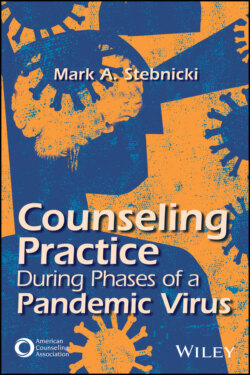Читать книгу Counseling Practice During Phases of a Pandemic Virus - Mark A. Stebnicki - Страница 19
Risk
ОглавлениеIt is difficult to provide a parsimonious definition of risk-taking as it relates to phases of a pandemic virus. This is because risk-taking is a multidimensional construct that involves thoughts, feelings, cognitions, experiences, and behaviors. It also involves risk-taking attitudes and behaviors that determine a range of decision-making strategies to safely navigate complex, uncertain, and dangerous activities (H. F. Chan et al., 2020). There is limited empirical evidence of psychologically based risk-taking behaviors measured during the COVID-19 pandemic. However, it is essential to understand that risk-taking is a multifaceted construct that is measurable and observable by oneself, others in the environment, and mental health practitioners. The intersection of agreement of these three observers (self, others, professionals) involves a complex equation defining What is risky behavior? The construct of risk-taking during the COVID-19 pandemic shares many characteristics and long-term implications for mental health with addictive and behavioral health concerns (Zvolensky et al., 2020). From a mental health perspective, risky patterns of behavior (i.e., suicidality, depression, anxiety, posttraumatic stress, substance use disorders) are well defined by diagnostic categories and decision trees in the fields of psychology, counseling, and mental health.
Risk also involves (a) the assessment of a situation, (b) the use of cognitions in the decision-making process, (c) acting on a decision, (d) the influence of neurobiological mechanisms on feelings and emotions, and (e) the navigation of complex environments associated with risk-taking behaviors (H. F. Chan et al., 2020). Regardless of how simplistic or complex the decision to take a risk is, the psychological adjustment and adaptation involved in living during phases of a pandemic virus creates unrelenting stress, anxiety, and fear for many Americans. Thus, the impact of taking risks during a pandemic virus may not be immediately known. For example, leaving your home to go shopping, go to work, and/or attend school may create apprehension and conflict between yourself, your family members, your environment, and society. Social, interpersonal, and intimate relationships are particularly strained during a pandemic virus. Risk-taking is inherently involved in maintaining these types of relationships and interactions. Thus, a risk–reward decision-making process occurs as the average American takes daily risks in many different life areas, such as virus hygiene and living intentionally with good medical, physical, mental, and behavioral health.
Risk-taking is indeed multidimensional in nature. There is strong empirical support for the effects that emotions play and the neurobiological consequences of risk-taking behaviors (Kusev et al., 2017). Accordingly, risk-taking is not solely a behavioral response. Rather, it has a mind-body component that propels the individual to action or inaction. For example, several key hormonal correlates act as determinants of risky behavior. We see this in the minirevolution of neuroscience related to veterans responding to combat operational stress and those diagnosed with posttraumatic stress disorders (Stebnicki, 2021a). For example, chronic sustained activation and elevation of cortisol, testosterone, and oxytocin levels have been associated with the modulation of healthy and unhealthy risk-taking behaviors. These hormones influence our cognitive-emotional patterns of behavior during the decision-making process. When the biophysiological markers of posttraumatic stress disorder are measured in the amygdala, the link between associative learning (Schiller et al., 2008) and the expression of other emotions (i.e., anger, sadness) is manifested by a host of mental health conditions (Lin et al., 2017).
Overall, there are critical pathways to taking unhealthy risks during phases of a pandemic disaster. Mental health practitioners are trained in distinguishing healthy risk-taking (e.g., asking the boss for a raise, trying out for the soccer team) from unhealthy risk-taking (e.g., using drugs and alcohol excessively, having unprotected sex, practicing poor virus hygiene). It is critical to recognize and understand the unique risk-taking behaviors of persons transitioning through phases of a pandemic disaster.
